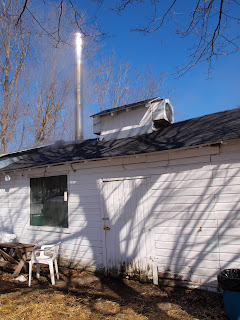Last weekend, Adam and I broke out the French press and took a trip across the border. This may be old hat to you northern Minnesota folks, but we had only the vaguest idea of how maple syrup arrived at our table. In my mind, this vat of simmering syrup generally summed up my impressions.
Our "sap to syrup" tour highlighted the modern conveniences of syruping, like an extensive array of plastic tubing to collect and return the sap from more than 3,500 trees, with each tap capable of producing about 10 gallons of sap per year.
Here, Adam listens to the regular pulsing of the sap as it returns, with the help of a vacuum pump, to holding bins.
Of course, you can also collect sap drop-by-drop in these blue bags if you're not connected to the tubing system. This may be an option for those do-it-yourself folks. You know who you are.
The holding bins collected the sap from the network. Not entirely sure what else happens here, as I was more obsessed with the regular flushing of the sap into different bins. Adam may know more about the physics; he sure asked a lot of questions for a Saturday morning.
The sap was boiled down in this little shed. It takes about 30-40 gallons of sap to produce one gallon of maple syrup, so think about that with your next batch of pancakes!

So, there you have it. I'm probably missing a few details, but it can't be all that hard. Our neighbor has been tapping his three maples over the past week or so and we live on less than a quarter-acre in town. This might be a great hobby to take up next year. As for me, I'll just invite myself to all the local pancake breakfasts. We're in the midst of Maple Syrup Month so I will expect nothing less with my flapjacks.











No comments:
Post a Comment